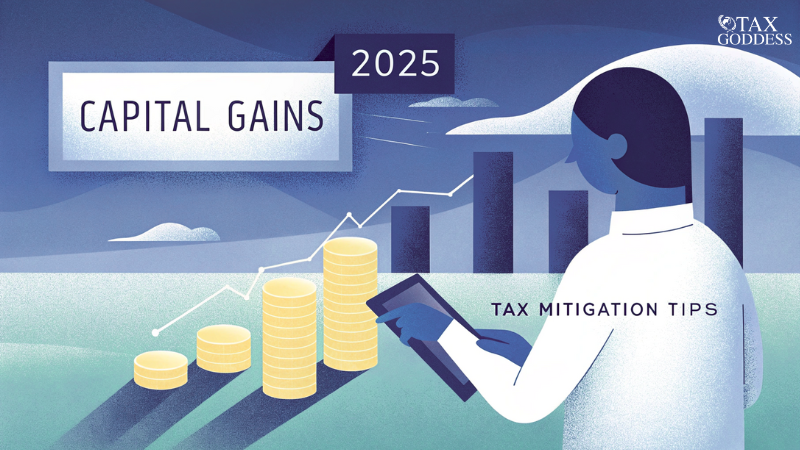The Hidden Tax Bite That Can Drain Your Profits
You’ve worked hard to make that big sale, sold that investment property, or see your stocks soar, only to discover that the IRS has its hand in your pocket, ready to take a chunk of your gains. The moment of realization hits: capital gains tax. It feels like a financial gut punch!
Every year, countless investors face the same tax headache. But here’s the good news: there are ways to fight back. With the right strategies, you can protect your profits and keep your hard-earned money where it rightfully belongs: your pocket. Let’s walk through seven proven capital gains tax mitigation strategies that can save you big in 2025.
1. Hold Investments for More Than a Year
Capital gains taxes work on a simple rule: the longer you hold an investment, the less tax you may owe.
- If you sell an asset you’ve owned for a year or less, the profit is taxed as ordinary income, and the rate could be as high as 37%.
- If you sell after more than a year, you’ll be taking advantage of the lower long-term capital gains rates (0%, 15%, or 20%) depending on your income.
This means that if you are close to reaching a one-year holding period, waiting a little longer before selling could result in a much lower tax bill.
2. Use Retirement Accounts to Defer Taxes
Investing through tax-advantaged accounts like 401(k)s, IRAs, and Roth IRAs can help avoid capital gains taxes while your money grows.
- If you contribute funds into a 401(k) or traditional IRA, you won’t owe capital gains tax when you buy and sell investments inside the account. Instead, you’ll pay taxes later when you withdraw the money—at this point, you may be in a lower tax bracket.
- A Roth IRA lets you withdraw your investment gains tax-free in retirement if you follow the rules.
For individuals nearing retirement, waiting until they stop working to sell taxable investments may also be a beneficial approach. If their income drops in retirement, their capital gains tax rate could be much lower, or even zero in some cases.
3. Offset Gains with Capital Losses
Not every investment makes money. If you sell an investment for a loss, you can use it to offset profits from other investments.
For example:
- You sell Stock A for a $10,000 profit.
- You sell Stock B for a $7,000 loss.
- You will only pay capital gains tax on the $3,000 net profit ($10,000 – $7,000).
You can use up to $3,000 annually to slash your taxable income if you make more losses than gains. You can also carry any losses beyond that into future years.
This strategy—often called tax-loss harvesting—can help lower your tax bill, especially in years when you’ve had significant gains.
Be careful of the “wash sale” rule. If you sell an investment at a loss and proceed to buy it within 30 days, the IRS won’t let you claim the loss on your taxes.
4. Be Strategic About When You Sell
Your capital gains tax rate depends on your total taxable income.
If you have flexibility in when you sell assets, it can make sense to spread sales across multiple years to take advantage of long-term capital gains tax rates and avoid pushing yourself into a higher tax bracket
For example:
- A single filer with less than $47,025 in taxable income in 2025 pays 0% capital gains tax.
- If that same person sells a large investment and pushes their income above that limit, they could suddenly owe 15% or 20% in capital gains taxes.
If possible, hold investments or assets for a longer period and time your sales to unlock favorable tax rates.
5. Consider a 1031 Exchange for Real Estate Sales
If you sell an investment property, you might qualify for a 1031 exchange, which allows you to delay paying capital gains tax if you reinvest the money in another property.
- You must trade one investment property for another of equal or higher value.
- The process must follow strict IRS rules, such as identifying a new property within 45 days and closing within 180 days.
- You don’t avoid capital gains tax forever, but you delay it, allowing your investments to grow without an immediate tax hit.
This only applies to business or rental properties, not personal homes.
6. Donate Appreciated Investments Instead of Selling
If you plan to make a charitable donation, you may get a double tax benefit by donating stocks, real estate, or other investments instead of selling them first.
Here’s why:
- If you sell an asset and then donate the cash, you’ll owe capital gains tax on the sale.
- Donating the asset directly to a charity helps you avoid capital gains tax entirely and still receive a charitable deduction on your taxes.
This is a powerful strategy for high-income earners and those looking to reduce taxes while supporting a cause they care about.
7. Choose Your Cost Basis Wisely
If you’ve bought shares of stock or mutual funds at different times and prices, the way you calculate your cost basis can impact how much tax you owe when you sell.
There are several methods you can use:
- First-in, First-out (FIFO): Oldest shares are sold first (often results in higher taxable gains).
- Last-in, First-out (LIFO): The newest shares are sold first (can minimize taxes in a rising market).
- Specific Share Identification: You pick which shares to sell (most tax-efficient but requires tracking).
Choosing the ideal cost basis method can lower your taxable gains and help you pay less.
8. Plan for Quarterly Tax Payments
If you sell an asset for a significant gain, the IRS expects you to pay taxes on it during the year, not just at tax time.
Failing to do this could result in penalties and interest.
If you expect to owe a lot in capital gains taxes, adjusting your estimated quarterly tax payments is best to avoid penalties.
Take Control of Your Taxes and Wealth in 2025
Capital gains tax doesn’t have to be the bogeyman of investing. By implementing these strategies, you can mitigate your tax burden and keep more of the money you’ve worked hard to earn. It’s all about being strategic, proactive, and informed.
Ready to make 2025 your most tax-efficient year yet? Whether it’s leveraging tax-advantaged investments or donating securities, the right strategy can make a world of difference. It’s time to take control, maximize your savings, and ensure your wealth works for you, not the taxman.
For personalized tax strategies, don’t hesitate to reach out to the Tax Goddess team. We’re here to help you navigate the complexities of tax season and protect your wealth year after year.








